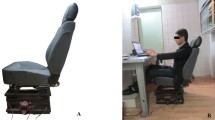Abstract
Objective
The goal of this study was to examine the effects of noise and whole-body vibration, individually and combined, and at various stimulus intensity levels, on cognitive performance and subjective experience.
Method
Fifty-four participants (27 men and 27 women) with a mean age of 25 years, ranging from 19 to 30, were exposed for 20 min each to a 16-Hz sinusoidal whole-body vibration, a helicopter sound at 21 Hz, both stimuli combined, and a control condition. Participants were randomly assigned to one of three groups: low intensity [77 dB(A) noise and 1.0 m/s2 vibration], medium intensity [81 dB(A)/1.6 m/s2] or high intensity [86 dB(A)/2.5 m/s2. During each environmental exposure, short-term memory performance was tested with a visual Sternberg paradigm. Reaction time was measured as a dependent variable. Directly following each environmental exposure, participants rated the difficulty of the task and the annoyance level of the exposure stimulus.
Results
Results revealed no significant changes in reaction times due to environmental exposure or intensity level. However, participants significantly rated the combined exposure as both more annoying and more difficult than the other conditions. Further, the high-intensity group rated subjective annoyance significantly higher than the other groups for all conditions.
Conclusions
The results from this study indicate that performance alone is not a sufficient measure for the study of the effects of combined stimuli on a human operator.


Similar content being viewed by others
References
Borg G (1998) Borg’s perceived exertion and pain scales. Human kinetics, Champaign, Ill
Gomes LMP, Martinho Pimenta AJF, Castelo Branco NAA (1999) Effects of occupational exposure to low frequency noise on cognition. Aviat Space Environ Med 70:115–118
Harris SC, Shoenberger RW (1980) Combined effects of broadband noise and complex waveform vibration on cognitive performance. Aviat Space Environ Med 51:1–5
Hygge S, Boman E, Enmarker I (2003) The effect of road traffic noise and meaningful irrelevant speech on different memory systems. Scand J Psychol 44:13–21
Lundström R, Landström U, Kjellberg A (1990) Combined effects of low-frequency noise and whole body vibration on wakefulness, annoyance and performance. Arch Complex Environ Study 2:1–7
Manninen O (1990) Further studies on changes in subjective stressfulness under various combinations of noise, vibration, temperature and work tasks. Arch Complex Environ Study 2:31–39
Persson Waye K, Bengtsson J, Rylander R, Hucklebridge F, Evans P, Clow A (2002) Low frequency noise enhances cortisol among noise sensitive subjects during work performance. Life Sci 70:745–758
Sandover J, Chapman DF (1984) Some effects of a combined noise and vibration environment on a mental arithmetic task. J Sound Vibration 95:203–212
Seidel H, Harazin B, Pavlas K, Sroka C, Richter J, Bluthner R, Erdmann U, Grzesik J, Hinz B, Rothne R (1988) Isolated and combined effects of prolonged exposures to noise and whole-body vibration on hearing, vision and strain. Int Arch Occup Environ Health 61:95–106
Seidel H, Erdmann U, Bluethner R, Hinz B, Braeuer D, Arias JF, Rothe HJ (1990) Evaluation of simultaneous exposures to noise and whole body vibration by magnitude estimation and cross-modality matching—an experimental study with professional drivers. Arch Comp Environ Study 2:17–24
Sherwood N, Griffin MJ (1990) Effects of whole-body vibration on short-term memory. Aviat Space Environ Med 61:1092–1097
Sherwood N, Griffin MJ (1992) Evidence of impaired learning during whole-body vibration. J Sound Vibration 152:219–225
Smith AP (1988) Acute effects of noise exposure: an experimental investigation of the effects of noise and task parameters on cognitive vigilance tasks. Int Arch Occup Environ Health 60:307–310
Smith AP (1991) Noise and aspects of attention. Brit J Psychol 82:313–324
Sommer HC, Harris CS (1973) Combined effects of noise and vibration on human tracking performance and response time. Aerospace Med 44:276–281
Acknowledgements
We would like to thank Aili Haasnoot for her assistance in collecting data and Bertil Nordström for his technical support.
Author information
Authors and Affiliations
Corresponding author
Rights and permissions
About this article
Cite this article
Ljungberg, J., Neely, G. & Lundström, R. Cognitive performance and subjective experience during combined exposures to whole-body vibration and noise. Int Arch Occup Environ Health 77, 217–221 (2004). https://doi.org/10.1007/s00420-003-0497-7
Received:
Accepted:
Published:
Issue Date:
DOI: https://doi.org/10.1007/s00420-003-0497-7




